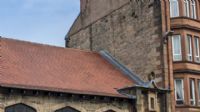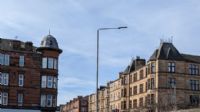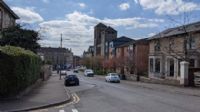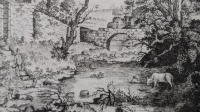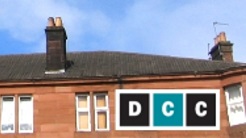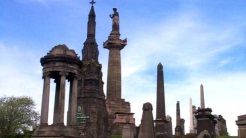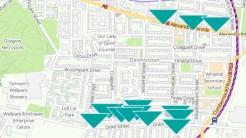The Dennistoun Story
Someone once described history as a series of dates relating to wars and battles, so I decided to call this contribution "The Dennistoun Story" rather than "The History of Dennistoun", as although there will be a few dates quoted, they are not the most important feature and there will certainly be very little mention of either wars or battles.
Dennistoun in my opinion must be one of the most unique districts in the City of Glasgow.
Let us consider our two neighbouring districts of Riddrie and Carntyne. A number of the streets in Riddrie are named after Scottish Rivers, while those in Carntyne take their names from districts of Edinburgh, like Abbeyhill, Inverleith, Myreside, but this tells us nothing about how these districts came into being. The Dennistoun Story, on the other hand, is mostly written in its street names. Find the origin of these names and you have the key to the Dennistoun Story.
Going back about three centuries, we find that the earliest name given to the area stretching East to West from Cumbernauld Road to the far end of the Necropolis just behind Glasgow Cathedral and North to South from Townmill Road to Duke Street is "the Craigs", taken from a rocky ridge of that name, which crossed from East to West over part of that area.
If we accept the street called Craigpark, (originally Craigpark Street) as roughly the centre of the area then from Craigpark eastwards to Cumbernauld Road was known as Eastern or Eastercraigs and from Craigpark to the far end of the Necropolis, Western or Westercraigs.
Eastercraigs and Westercraigs were made up of private estates and Parklands. The street named Eastercraigs is beside the main entrance to Alexandra Park, while Westercraigs is off Duke Street facing Bellgrove Street.
The old divisions of Eastercraigs and Westercraigs were made up of private estates at one time or another, the names of nine estates and parklands can be found.
The three estates of Eastercraigs were named Craigpark, Whitehill and Meadowpark.
Craigpark, named after the Craigs was situated on the north side of Eastercraigs, stretching halfway to Duke Street. Whitehill, at the south side of the area, ran from Duke Street upwards to the boundary of Craigpark. It took its name from the fact that in the vicinity of this estate stood a large number of whitish coloured rocks. Meadowpark was the estate furthest east, beside Cumbernauld Road. It was also known as the middle Park and had once formed part of the estate of Whitehill before being sold off and becoming a separate estate. Meadowpark would appear to have stood on the site later occupied by Golfhill Cricket Club, whose ground was also named Meadowpark.
The three estates of Eastercraigs have given their names to several streets in the eastern half of Dennistoun, such as Craigpark, Craigpark Drive, Craigpark Terrace, Whitehill Street, Whitehill Gardens, and Meadowpark Street.
Three of the divisions of Westercraigs can be quickly dealt with. They were named East Park, Wellacre Park and Cack o' the Brae Park. They were probably parklands surrounded by dry stone dykes and their names have not survived.
Of the other six Westercraigs estates, the furthest west was Craig's Park, which is occupied by the Necropolis or burial ground. In 1717, after a number of fir trees were planted in the Craig's Park, the name was changed again to Merchants Park, but this name proved unpopular and the locals continued to use the name Firpark. This can be judged by the fact that in Dennistoun today there is no commemoration of Merchants Park, while along the eastern boundary of the Necropolis is Firpark Street, with Firpark Terrace at the lower end of this street.
At the north side of Westercraigs was the estate of Golfhill, remembered in Golfhill Drive. Apparently before Golfhill became a private estate, the game of golf was played there and when the new estate was enclosed, the locals were unhappy at the loss of their golf course.
The estate of Broompark has given us Broompark Street, Broompark Drive and Broompark Circus.
Hillpark estate is not commemorated by that name, but the lower part of this estate was known as the Hill Foot, which gives us Hillfoot Street.
Parkhouse estate used to be commemorated by Parkhouse Lane, which was just to the left of Tennent's Brewery and ran at an angle from Duke Street to Ladywell Street. When the Tennent-Caledonian combine took over the brewery, they put up a new building on the site of Parkhouse Lane, but the name has been preserved as they have called this building "Park House" and the name can be seen above the doorway beside the main entrance.
The original Brewery was opened by the brothers J & R Tennent in Arklane in 1780 and the name of Wellpark Brewery was taken from the neighbouring estate of Wellpark. There is a Wellpark Street, but it seems rather out of place as it is on the opposite side of Duke Street from the brewery and runs between Sydney Street and Melbourne Street.
The first person to get the idea of creating a new residential suburb in the east side of Glasgow was John Reid, a successful Glasgow businessman. In 1838 he bought the estate of Annfield, which was not one of the Craigs estates but one of the estates of the Gallowgate area. Annfield stretched from Gallowgate to Duke Street along the east side of what is now Bellgrove Street, but was originally known as the Witch Lane.
In 1841 Reid bought the property known as Scarlet Hall on the opposite side of Witch Lane. At this time Witch Lane was merely a cattle track, but Reid improved it and widened it to a serviceable street.
In 1843 Reid bought Bellfield, the next estate to Annfield, thus extending his property to the border of Whitehill Street.
Later that same year he bought Whitehill and moved from the mansion house of Annfield to that of Whitehill, which was situated slightly to the east of where the old Whitehill School used to stand.
In 1844 he bought Meadowpark, having also taken over some property in Westercraigs section.
Building was eventually started on the Annfield/Bellfield site and if John Reid's plan had succeeded, it is unlikely that there would have been a district named Dennistoun, as his intention was to call the new suburb by his own name probably Reidstown, with streets having names like Reidpark and Reidhill.
However, John Reid dies suddenly at Whitehill House in 1852. His ambition to put his name on the proposed new suburb was not realised but the first street in process being built at the time of his death was dedicated to his memory - Reidvale Street.
Now into our story comes the family who eventually did succeed in putting their name on the district -Â the Dennistoun family. Originally of Norman descent, the Dennistoun name appears in the records of the court of King Malcolm iV of Scotland and as he died in 1165, the family has a long association with this country.
At the beginning of the nineteenth century, the brothers James and Alexander Dennistoun were partners in a very successful shipping company with headquarters in Glasgow, a branch in Liverpool and overseas branches in America and Australia.
In 1814, James Dennistoun (1752-1835) took up residence in this area when he bought the vacant estate of Golfhill from the trustees of the previous owner, Jonathan Anderson. James Dennistoun's first move was to build a new mansion, Golfhill House, which was situated slightly east of where the present Golfhill School stands.
James Dennistoun was a keen supporter of the Liberal Party and had worked hard for the success of the Parliamentary Reform Bill, which was passed in 1832. In return for his hard work, he was offered a knighthood by the Prime Minister, Earl Grey. He refused this honour, as he felt that people might believe that all his hard work was done for personal gain. People today still refer to him as "Lord Dennistoun", but this was probably an unofficial title bestowed on him by the people when they learned that he had turned down a knighthood.
James Dennistoun died in 1835 and was succeeded at Golfhill by his eldest son, Alexander (1790-1874) who, earlier that same year had been elected Liberal Member of Parliament for North Dumbarton. He soon found that parliamentary life was not to his liking and resigned his seat.
For the next fourteen or fifteen years little is heard of Alexander Dennistoun except that he was now Managing Director of the family shipping business and a senior partner with his youngest brother, John.
Then in 1850 he made his first move. The estate of Craigpark was vacant due to the death of the previous owner, James MacKenzie. In 1806 MacKenzie had been elected Lord Provost of Glasgow and in 1820 had opened on his estate, Craigpark Whinstone Quarry, which had supplied most of the material for the making of Glasgow's macadamised roads. Alexander Dennistoun purchased Craigpark from MacKenzie's trustees and this was an interesting arrangement as it gave him as a near neighbour, John Reid, who at that time was resident at Whitehill House.
It would seem certain that these two men got to know each other and that Alexander Dennistoun was suitably impressed by John Reid's plans for a new residential suburb, because after the death of John Reid in 1852, within the next year Mr. Dennistoun had acquired the estates of Whitehill and Meadowpark, thus giving him control over the whole of Eastercraigs. He also bought up the properties adjacent to Golfhill and in 1856, he engaged the services of a local architect, James Salmon, who drew up plans of all his properties. Alexander Dennistoun not only had plans of his properties drawn up but he also indicated where he wished the streets, drives and terraces of the proposed new suburb to be placed and as he also named them, it is to him that we are indebted for being able to tell the Dennistoun Story from its street names.
The architect's plans showed that Alexander Dennistoun's territory extended from Cumbernauld Road to the eastern boundary of the Fir Park and from Townmill Road to Duke Street, all the property of the old Craigs estates with the exception of the Fir Park, which was to become the Necropolis.
In 1857 the ground was prepared for building, beginning near the foot of Westercraigs and Craigpark. While digging at Craigpark, stones and fossils were discovered of a rather unusual type. Experts decreed that these were similar to those usually to be found only in the Arctic regions and they claimed this as proof that this area had at one time been under ice, thus connecting it to the period of civilisation which we know of as the Ice Age.
The new suburb was to be named Dennistoun and Alexander Dennistoun's plan was to create a model suburb made up of self-contained or villa type houses. With this end in view the first house was built in Westercraigs in 1861 and Westercraigs, Craigpark and all the streets connecting them were built up. The locals named this part of Dennistoun - Villadom.
Alexander Dennistoun next turned his attention to what is now Onslow Drive and commenced building eastwards from the Craigpark end. It will be noted that Onslow Drive only has self-contained houses as far as its junction with Whitehill Street, the reason being that Alexander Dennistoun died in 1874. Building ceased for some years and eventually the people began to demand cheaper and more compact types of houses. Accordingly when building recommenced in 1890, the remainder of Onslow Drive and the rest of Dennistoun's streets were built as sandstone tenements. This was a blow to the architect, James Salmon, who was entirely in favour of Alexander Dennistoun's original plan.
If many of the streets in Dennistoun were named after the old Craigs estates, many of the others read like a litany of the Dennistoun family.
FINLAY DRIVE - James Dennistoun's wife was May Finlay of Moss, Stirlingshire.
There used to be a Moss Street off Circus Drive. It is now Circus Place, but the old name can still be seen on the left hand corner house.
GARTHLAND DRIVE - After the death of his wife, Mary, James Dennistoun remarried. The second of three daughters of this marriage, Isabella married William McDowall of Garthland, Wigtonshire.
INGLEBY DRIVE - The McDowalls daughter Eleanor married William Ingleby, brother of Sir Henry Ingleby.
ONSLOW DRIVE - John, youngest son of James Dennistoun, married Frances Onslow, daughter of Sir Henry Onslow.
ROSLEA DRIVE - The Dennistoun family had a country estate named Roslea at Lagarie in the Gareloch.
ARMADALE STREET - When John Dennistoun retired from business, he took over a country estate at Armadale on the Gareloch, near the old family estate at Roslea.
SETON TERRACE - Elizabeth, daughter of Alexander Dennistoun was the wife of Seton Thomson.
OAKLEY TERRACE - Alexander Dennistoun's son, Alexander married Georgina, daughter of Sir Charles Oakly.
In the 1890's the house at the corner of Craigpark and Oakley Terrace was owned by Sir William Arrol, the great engineering genius, who was chiefly responsible for the building of the Forth Rail Bridge, which had its centenary in 1990.
CLAYTON TERRACE - Another daughter of Sir Charles Oakley was married to a Mr. Clayton, whose first name I have been unable to trace.
The Dennistoun Story by Edward Farren (1915-2005)
Mr Farren lived in Dennistoun most of his adult life. I gratefully thank his family for kindly giving permission to publish his article.


